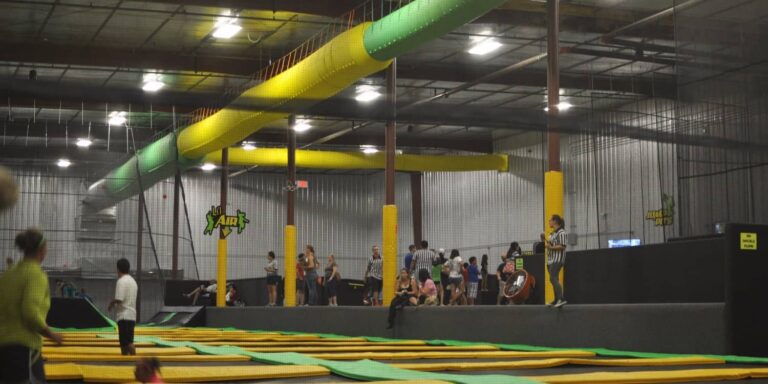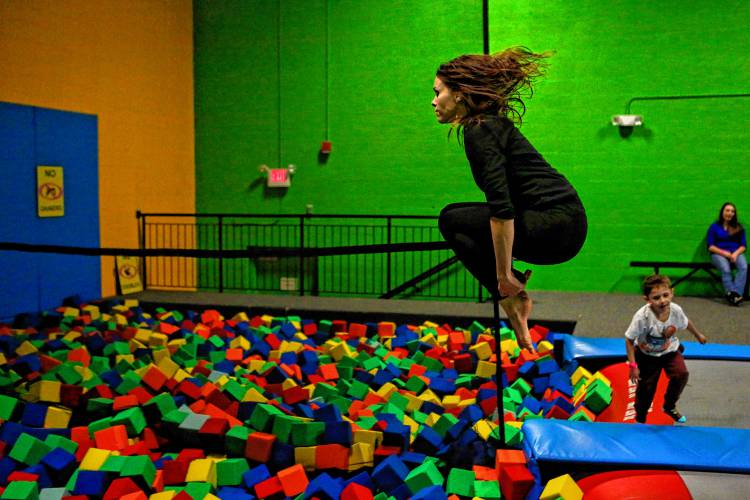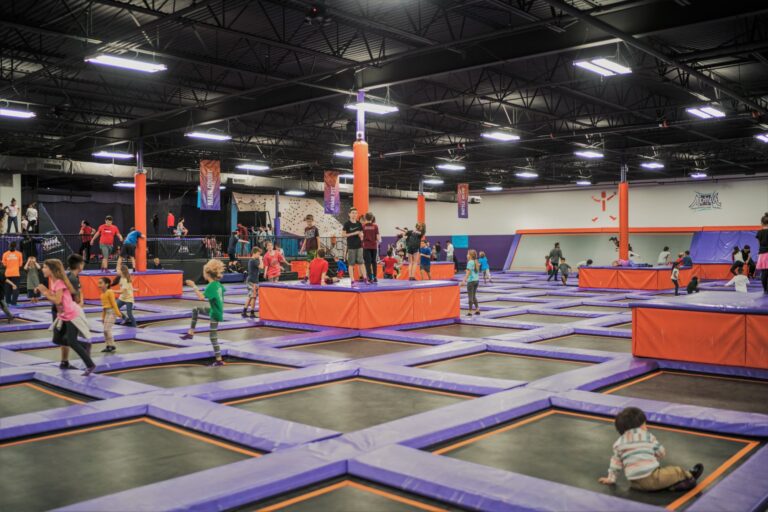Trampoline Safety 101: A Guide to Enjoying Indoor Trampoline Parks
1. Understanding Trampoline Safety
Importance of Safety Guidelines
The importance of safety guidelines cannot be overstated when it comes to enjoying indoor trampoline parks. These guidelines are put in place to ensure the well-being and protection of all visitors. Trampolines can be a fun and exhilarating activity, but without proper safety measures, accidents and injuries can occur. By following the established safety guidelines, visitors can minimize the risk of accidents and enjoy their time at the trampoline park with peace of mind. These guidelines typically include rules such as jumping within one’s abilities, avoiding dangerous stunts, and maintaining a safe distance from other jumpers. It is crucial for both children and adults to familiarize themselves with these guidelines and adhere to them at all times to create a safe and enjoyable environment for everyone.
Proper Trampoline Usage
Proper Trampoline Usage is crucial to ensure a safe and enjoyable experience at indoor trampoline parks. Firstly, it is important to always follow the park’s rules and guidelines. These rules are put in place to protect the safety of all visitors. Additionally, it is essential to jump within your skill level and avoid attempting advanced tricks or flips without proper training. Maintaining control and being aware of your surroundings is also key. Avoid jumping too close to other people and always give them enough space. Lastly, it is recommended to jump with bare feet or wear non-slip socks to prevent slipping. By adhering to these guidelines, you can maximize your fun while minimizing the risk of injuries.
Supervision and Age Restrictions
Supervision and age restrictions are crucial aspects to consider when visiting indoor trampoline parks. These parks typically have specific rules and guidelines in place to ensure the safety of all participants. It is important to note that children should always be supervised by a responsible adult while using the trampolines. This helps to prevent any potential accidents or injuries and ensures that children are using the equipment correctly. Additionally, many trampoline parks have age restrictions in place to ensure that participants are of an appropriate age and size to safely enjoy the activities. These restrictions are in place to minimize the risk of collisions or accidents between participants of varying ages and abilities. By adhering to the supervision and age restrictions set by the trampoline park, visitors can have a fun and safe experience.
2. Choosing a Reputable Trampoline Park
Researching Trampoline Parks
Researching Trampoline Parks is an essential step in ensuring a safe and enjoyable experience. Before visiting any indoor trampoline park, it is crucial to conduct thorough research to gather information about the park’s safety measures, reputation, and customer reviews. Start by checking the park’s website for details on their safety protocols, certifications, and staff training. Additionally, read online reviews and testimonials from previous visitors to get an idea of their experiences and overall satisfaction. It is also advisable to inquire about the park’s maintenance schedule and how frequently their trampolines are inspected for any potential hazards. By conducting proper research, you can make an informed decision and choose a trampoline park that prioritizes safety and provides a fun-filled environment for everyone.
Checking Safety Certifications
When visiting an indoor trampoline park, it is crucial to prioritize safety. One way to ensure the park’s commitment to safety is by checking for proper safety certifications. These certifications indicate that the park has met specific safety standards and regulations. Look for certifications from reputable organizations such as the International Association of Trampoline Parks (IATP) or the American Society for Testing and Materials (ASTM). These certifications demonstrate that the park has undergone rigorous inspections and has implemented safety measures to protect visitors. By choosing a trampoline park with the appropriate safety certifications, you can have peace of mind knowing that your enjoyment will not come at the expense of your safety.
Reading Reviews and Recommendations
Reading reviews and recommendations is an essential step before visiting an indoor trampoline park. By taking the time to read about other people’s experiences, you can gain valuable insights into the safety measures, cleanliness, and overall enjoyment of the park. Look for reviews that mention the park’s adherence to safety guidelines, such as proper padding and netting, as well as staff attentiveness. Pay attention to any negative feedback regarding maintenance issues or overcrowding, as these factors can impact your experience. Additionally, recommendations from friends or family who have visited trampoline parks can provide firsthand information and help you make an informed decision. Remember, prioritizing safety and quality will ensure a fun and worry-free trampoline park experience.
3. Preparing for a Trampoline Park Visit
Wearing Appropriate Attire
When visiting an indoor trampoline park, it is essential to wear appropriate attire to ensure your safety and enjoyment. The first thing to consider is wearing comfortable clothing that allows for easy movement. Avoid loose or baggy clothing that may get caught in the trampoline springs or obstruct your movements. It is also recommended to wear athletic shoes with good grip to prevent slipping. Additionally, it is crucial to remove any jewelry, including earrings, necklaces, and bracelets, as they can pose a risk of getting caught or causing injury. By wearing the right attire, you can fully enjoy your trampoline experience while minimizing the risk of accidents or discomfort.
Stretching and Warm-up Exercises
Stretching and warm-up exercises are essential before engaging in any physical activity, including trampolining. These exercises help to prepare the body for the intense movements and jumps that will be performed on the trampoline. Before starting your trampoline session, it is important to spend a few minutes stretching your muscles to increase flexibility and prevent injuries. Simple stretches such as toe touches, arm circles, and leg swings can help loosen up the muscles and joints. Additionally, performing light aerobic exercises like jogging or jumping jacks can help raise your heart rate and warm up your body. By incorporating stretching and warm-up exercises into your trampoline routine, you can enhance your performance and reduce the risk of strains or sprains.
Understanding Park Rules and Regulations
Understanding Park Rules and Regulations is crucial for ensuring a safe and enjoyable experience at indoor trampoline parks. These rules are put in place to protect the well-being of all visitors and prevent any potential accidents or injuries. It is important to familiarize yourself with the specific rules of the park you are visiting, as they may vary slightly from one location to another. Common regulations include guidelines on age restrictions, maximum weight limits, and the proper use of trampolines and other park facilities. By adhering to these rules, you can help create a safe environment for yourself and others, allowing everyone to fully enjoy the exhilarating fun that trampoline parks offer.
4. Trampoline Park Safety Features
Quality and Maintenance of Trampolines
When it comes to the quality and maintenance of trampolines, it is crucial to prioritize safety and ensure proper upkeep. High-quality trampolines are built with durable materials and sturdy frames that can withstand regular use and provide a stable jumping surface. Regular maintenance is essential to keep trampolines in optimal condition. This includes inspecting the trampoline for any signs of wear and tear, such as loose springs or torn jumping mats, and promptly addressing any issues. Additionally, regular cleaning and proper storage during periods of non-use can help extend the lifespan of the trampoline. By investing in a high-quality trampoline and maintaining it properly, users can enjoy a safe and enjoyable jumping experience.
Safety Net Enclosures
Safety net enclosures are an essential feature of indoor trampoline parks, providing an added layer of protection for jumpers. These enclosures consist of high-quality netting that surrounds the trampoline area, preventing users from accidentally bouncing off the trampoline and onto the hard floor. The netting is designed to be durable and resistant to tearing, ensuring that it can withstand the impact of energetic jumpers. Additionally, the netting is securely attached to the trampoline frame, minimizing the risk of it coming loose during use. With safety net enclosures in place, both children and adults can enjoy their trampoline experience with peace of mind, knowing that they are protected from potential falls or accidents.
Padded Surfaces and Foam Pits
Padded surfaces and foam pits are essential safety features in indoor trampoline parks. These cushioned areas provide a soft landing surface, reducing the risk of injuries when jumping or performing tricks on the trampolines. The padded surfaces are typically made of high-density foam or other impact-absorbing materials, ensuring a comfortable and safe experience for trampoline park visitors. Foam pits, on the other hand, are deep pits filled with foam cubes where jumpers can safely practice more advanced moves or flips. These pits offer an extra layer of protection, allowing individuals to try out new tricks with reduced fear of injury. It is important to always follow the rules and guidelines set by the trampoline park to ensure a safe and enjoyable experience on these padded surfaces and in foam pits.
5. Safe Trampoline Techniques and Etiquette
Bouncing and Jumping Techniques
When it comes to bouncing and jumping on trampolines, it is important to remember a few key techniques to ensure a safe and enjoyable experience. Firstly, always start with a gentle bounce to get a feel for the trampoline’s responsiveness. As you become more comfortable, gradually increase the height and intensity of your jumps. Remember to keep your body centered and balanced, using your arms for stability. It is also crucial to land with your knees slightly bent to absorb the impact and avoid any strain on your joints. Lastly, avoid attempting any advanced tricks or flips unless you have received proper training and supervision. By following these bouncing and jumping techniques, you can make the most out of your time at an indoor trampoline park while keeping safety a top priority.
Avoiding Dangerous Tricks
When it comes to enjoying indoor trampoline parks, it is important to prioritize safety and avoid engaging in dangerous tricks. While trampolines can provide a fun and exhilarating experience, attempting risky maneuvers can increase the risk of accidents and injuries. To ensure a safe trampoline session, it is advisable to refrain from attempting flips, somersaults, or any other advanced tricks unless you have received proper training and supervision. Stick to basic jumps and controlled movements to minimize the chances of falls or collisions with other jumpers. Remember, the goal is to have a fun and enjoyable time while keeping yourself and others safe.
Respecting Other Jumpers
Respecting other jumpers is crucial when visiting indoor trampoline parks. It is important to be mindful of the space around you and to avoid reckless or dangerous behavior that could potentially harm others. Always be aware of your surroundings and give other jumpers enough space to safely enjoy their time on the trampolines. Avoid cutting in front of others or engaging in any activities that may disrupt their experience. Additionally, it is essential to follow any rules or guidelines set by the park to ensure a safe and enjoyable environment for everyone. By respecting other jumpers, we can all have a fun and accident-free experience at indoor trampoline parks.
6. Common Trampoline Park Injuries and Prevention
Sprains, Strains, and Fractures
Sprains, strains, and fractures are common injuries that can occur while enjoying indoor trampoline parks. These types of injuries often happen when individuals land awkwardly or incorrectly on the trampoline surface, or when they collide with other jumpers. Sprains and strains can result in pain, swelling, and limited mobility, while fractures can cause severe pain and require medical attention. To minimize the risk of these injuries, it is important to follow the safety guidelines provided by the trampoline park, such as jumping within your skill level, avoiding risky maneuvers, and always being aware of your surroundings. Additionally, warming up before jumping and using proper jumping techniques can help reduce the likelihood of sprains, strains, and fractures.
Head and Neck Injuries
Head and neck injuries are a significant concern when it comes to trampoline safety. The high-energy bouncing and flipping movements can put immense strain on the head and neck, making them vulnerable to injuries. Common head and neck injuries include concussions, whiplash, and spinal cord injuries. To minimize the risk of these injuries, it is crucial to follow proper jumping techniques and guidelines provided by the trampoline park. It is also essential to ensure that the trampoline is in good condition and has adequate padding and safety nets. Additionally, participants should avoid attempting risky stunts or flips without proper training and supervision. By being cautious and mindful of head and neck safety, individuals can enjoy the exhilarating experience of indoor trampoline parks while reducing the risk of serious injuries.
Preventing Injuries through Awareness and Education
Preventing Injuries through Awareness and Education
Awareness and education play a crucial role in ensuring the safety of individuals at indoor trampoline parks. By promoting awareness about potential risks and providing comprehensive education on trampoline safety, we can significantly reduce the occurrence of injuries. It is essential for both park operators and visitors to be well-informed about the proper use of trampolines, including understanding the importance of following park rules and guidelines. Additionally, educating visitors about the potential risks associated with certain activities, such as flips or somersaults, can help them make informed decisions and avoid unnecessary injuries. Regular safety briefings, signage, and informative materials can all contribute to creating a culture of safety and responsibility within trampoline parks. Ultimately, by prioritizing awareness and education, we can ensure that everyone can enjoy the exhilarating experience of indoor trampolining while minimizing the risk of injuries.







